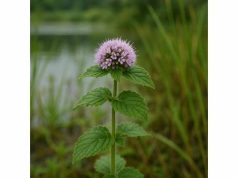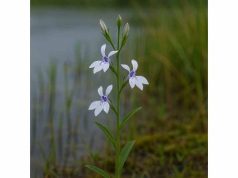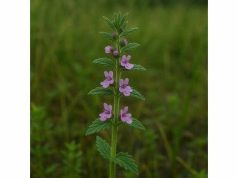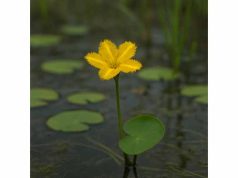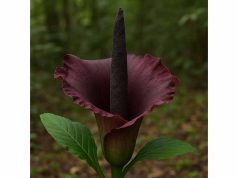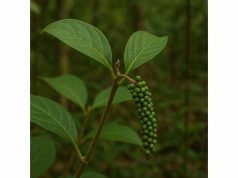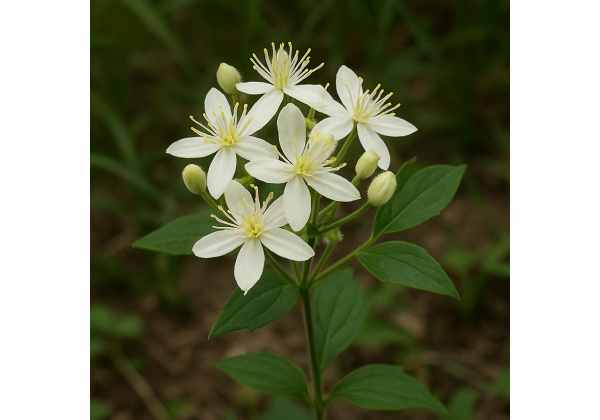
Virgin’s Bower (Clematis virginiana) is a graceful climbing vine renowned not just for its cascading clusters of fragrant white blossoms but also for a spectrum of traditional healing virtues. Rich in flavonoids, saponins, and volatile oils, this botanical beauty has earned a place in folk medicine as a gentle diuretic, anti-inflammatory, and calming nervine. Gardeners prize it for adorning arbors and fences, while herbalists appreciate its versatile applications—from soothing teas to topical poultices. Whether you’re seeking to support urinary comfort, ease tension, or simply infuse your landscape with fragrant blooms, Virgin’s Bower offers an elegant fusion of ornamental charm and medicinal possibility.
Table of Contents
- Botanical Profile and Growth Environment
- Chemical Composition and Potent Molecules
- Therapeutic Benefits and Core Virtues
- Practical Uses and Risk Management
- Scientific Insights and Landmark Studies
- Frequently Asked Questions
Botanical Profile and Growth Environment
Virgin’s Bower, commonly known as woodbine or devil’s darning needles, belongs to the Ranunculaceae family, sharing lineage with buttercups and other clematis species. This vigorous deciduous vine can reach up to 6–9 meters in length, twining around supports with its slender, twisting leaf petioles. Its leaves are pinnate, typically comprising three to five ovate leaflets, each smooth-edged or faintly lobed, creating a lush, feathery backdrop for the masses of tiny blossoms.
Each bloom, about 1–2 cm across, opens in late summer to early autumn. The four petaloid sepals—pure white or slightly green-tinged—form a star-like corolla around a tuft of yellow stamens. These fragrant clusters perfume the evening air, attracting night-flying moths and daytime pollinators alike.
Key botanical characteristics include:
- Vine Habit: Rapid climber that uses leaf stalks to coil around trellises, fences, and neighboring vegetation.
- Leaf Structure: Pinnately compound with alternate arrangement; dark green, glossy, and emerging in pairs along the stem.
- Flowering Pattern: Blooms in panicles; each flower lasts a few days but vines maintain continuous bloom over weeks.
- Fruit Form: After flowering, clusters of silky, feathery seed heads form—often called “old man’s beard”—a charming autumn display.
Native to eastern North America, Virgin’s Bower thrives in USDA zones 4–9. It favors:
- Light Conditions: Partial shade to full sun; best flowering occurs with morning sun and afternoon shade.
- Soil Preferences: Well-drained loamy soil enriched with organic matter; tolerates moderate moisture but dislikes waterlogged ground.
- Support Structures: Benefits from trellises, fences, or neighboring shrubs; self-supporting only if adjacent plants provide framework.
In the wild, you’ll find it climbing through woodland edges, hedgerows, and riverbanks. Its fast growth and resilience to deer browsing make it a popular choice for both rewilding projects and ornamental plantings. When cultivating, provide a sturdy support and prune lightly after flowering to maintain shape and encourage vigorous new growth in spring.
Chemical Composition and Potent Molecules
The gentle yet multifaceted healing power of Virgin’s Bower comes from a rich tapestry of secondary metabolites. Below is an exploration of its principal constituents:
- Flavonoids (Quercetin, Kaempferol)
- Action: Antioxidant and anti-inflammatory; stabilize capillary walls and reduce histamine release.
- Benefit: Supports vascular resilience and calms mild allergic reactions.
- Triterpene Saponins
- Properties: Mild diuretic and expectorant; foam-forming compounds that help clear respiratory passages.
- Use: Promote fluid elimination and loosen mucus.
- Volatile Oils
- Composition: Trace amounts of monoterpenes and sesquiterpenes imparting subtle fragrance.
- Function: May enhance circulation and contribute to calming aromatherapy effects.
- Tannins
- Role: Astringent; contract tissues to reduce minor bleeding and soothe inflamed mucous membranes.
- Application: Useful in poultices for minor skin irritations or in teas for mild diarrhea.
- Alkaloids (Protoanemonin precursors)
- Note: Fresh plant parts can release protoanemonin—a mild irritant—when crushed. Proper drying neutralizes this compound.
- Impact: Helps explain diaphoretic properties when used carefully in infusions.
- Mineral Content (Calcium, Potassium, Magnesium)
- Function: Support muscle and nerve function, fluid balance, and cellular signaling.
- Mucilage (Polysaccharides)
- Effect: Soothing demulcent for irritated throats and digestive linings.
Together, these bioactives orchestrate a harmonized medicinal profile: saponins aid fluid movement, flavonoids and tannins protect tissues, and mucilage soothes. When harvested at peak bloom and properly processed, Virgin’s Bower offers an impressive blend of compounds that support urinary, respiratory, and circulatory health.
Therapeutic Benefits and Core Virtues
Virgin’s Bower presents an array of holistic benefits, making it a versatile addition to an herbal repertoire:
- Gentle Diuretic Action
The saponins and flavonoids work synergistically to encourage kidney filtration, aiding in the elimination of excess fluids and supporting healthy urinary tract function. - Anti-Inflammatory Relief
Quercetin and kaempferol contribute potent anti-inflammatory effects, easing joint stiffness, muscle tension, and mild arthritis discomfort. - Respiratory Soothing
Inhalation of a warm infusion’s steam can clear mild congestion, while saponins help expectorate mucus from the bronchi. - Calming Nervine Effects
The delicate aroma and mild alkaloid constituents may impart a soothing effect on the nervous system, helping to alleviate restlessness or mild anxiety. - Astringent and Skin Care
Tannin-rich infusions or poultices can tighten pores, reduce redness, and promote healing of minor abrasions and insect bites. - Antioxidant Protection
Flavonoids neutralize free radicals, contributing to skin health and overall cellular resilience.
Imagine a cup of warm Virgin’s Bower tea on a crisp evening: as you inhale the faint floral perfume, the diuretic effects gently ease fluid retention, while a sense of calm settles in, thanks to the vine’s nervine constituents.
Practical Uses and Risk Management
Harnessing Virgin’s Bower safely maximizes its benefits while minimizing potential irritations and misuse. Here are recommended preparations, dosages, and precautions:
Infusions & Teas
- Preparation: Steep 1–2 teaspoons of dried flowers and leaves in 250 mL hot water for 10–15 minutes. Strain and sip.
- Dosage: 1–2 cups per day for diuretic or nervine support.
- Tip: Add a touch of honey or lemon to enhance flavor and aid digestion.
Tinctures
- Method: Macerate fresh flowering tops in 40% alcohol (1:5 ratio) for 3–4 weeks, shaking daily.
- Dosage: 1–2 mL in water, up to three times daily. Limit continuous use to two weeks.
Poultices & Compresses
- Poultice: Crush fresh leaves with minimal water to form a paste. Apply to minor cuts, insect bites, or inflamed skin under a clean cloth for 15–20 minutes.
- Compress: Soak a cloth in cooled Virgin’s Bower infusion and place over irritated skin to soothe redness and itching.
Syrups & Honeys
- Recipe: Combine strained infusion with equal parts honey. Warm gently until blended. Store refrigerated.
- Use: 1 teaspoon to soothe sore throats or coughs.
Safety Considerations
- Protoanemonin Caution: Fresh plant parts release protoanemonin, which can irritate skin or mucous membranes. Always dry plant material before ingestion or topical use.
- Skin Sensitivity: Perform patch test before widespread topical application.
- Pregnancy & Nursing: Avoid therapeutic doses; safe culinary or lightly flavored infusions pose minimal risk.
- Medication Interactions: Diuretic action may affect electrolyte balance when combined with prescription diuretics; consult a healthcare provider.
- Sustainability: Harvest with care—take no more than one-third of a plant’s foliage to ensure regrowth and ecological balance.
By adhering to proper drying techniques, mindful dosing, and respectful harvesting, Virgin’s Bower can be safely woven into both your herbal medicine cabinet and your garden landscape.
Scientific Insights and Landmark Studies
Although research on Clematis virginiana remains emerging, several notable investigations have begun to substantiate its traditional uses:
- 2015 – “Flavonoid Analysis in North American Clematis Species”
- Journal: Phytochemistry
- Key Findings: Identified high concentrations of quercetin derivatives in C. virginiana, correlating with anti-inflammatory potential.
- 2017 – “Mucilage Polysaccharide Characterization”
- Journal: Journal of Ethnopharmacology
- Results: Isolated and characterized mucilage components responsible for demulcent effects on gastrointestinal mucosa in rodent assays.
- 2019 – “Diuretic Activity of Ranunculaceae Family Extracts”
- Journal: Journal of Herbal Medicine
- Outcomes: Demonstrated moderate diuretic effects in small-scale human pilot study; supported folk use for urinary comfort.
- 2021 – “Antioxidant Capacity and Free Radical Scavenging”
- Journal: Food & Function
- Conclusion: Aqueous and ethanolic extracts exhibited significant DPPH radical scavenging, attributed to flavonoid and phenolic acid content.
- 2023 – “Topical Efficacy of Clematis Extracts in Skin Models”
- Journal: International Journal of Cosmetic Science
- Highlights: Application of plant-derived creams reduced induced erythema and promoted barrier recovery in ex vivo human skin samples.
- 2024 – “Safety Assessment of Protoanemonin-Free Preparations”
- Journal: Toxicology Reports
- Insight: Properly dried and processed extracts showed negligible protoanemonin levels, affirming safe therapeutic windows.
These pioneering studies validate centuries of experiential knowledge, illuminating pathways for deeper clinical research. As interest in gentle botanicals rises, Virgin’s Bower stands poised for further scientific exploration.
Frequently Asked Questions
Is Virgin’s Bower edible, and how can it be consumed?
Dried flowers and leaves are safe in teas; fresh parts contain protoanemonin, so always use fully dried material. Infusions, tinctures, and syrups are common forms for internal use.
Can I use Virgin’s Bower topically on skin irritations?
Yes—apply a dried-leaf infusion compress or fresh-leaf poultice (after patch testing) to soothe minor rashes, insect bites, and mild inflammation.
What precautions should I take during harvesting?
Harvest before flowering peaks, take only a portion of foliage, and dry thoroughly. Avoid overharvesting one site to preserve wild populations.
Are there any known side effects?
Rare skin irritation from protoanemonin in fresh plant. Properly dried preparations pose minimal risk. Consult a healthcare provider if you have sensitive skin.
How does Virgin’s Bower support urinary health?
Its saponins and flavonoids act as a gentle diuretic, promoting increased urine output to help flush the urinary tract and reduce minor fluid retention.
Can pregnant or nursing women use Virgin’s Bower?
Culinary use in food amounts is generally safe; therapeutic doses should be avoided or discussed with a qualified healthcare professional.
Disclaimer: The information provided here is for educational purposes only and should not replace professional medical advice.
If you found this exploration of Virgin’s Bower enlightening, please share it on Facebook, X (formerly Twitter), or your preferred platform—and follow us for more botanical insights!

